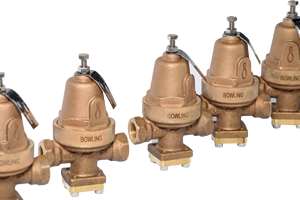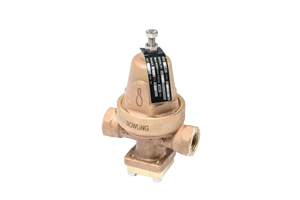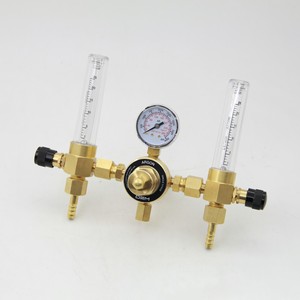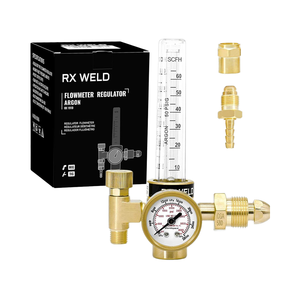
All categories
Featured selections
Trade Assurance
Buyer Central
Help Center
Get the app
Become a supplier

(9583 products available)




































Pressure regulators are critical components in various industrial and manufacturing systems. By controlling outlet pressure and flow, they ensure processes use gases like argon stably and efficiently. Here are some common types based on outlet pressure range, single or dual, and others.
A single-stage argon co2 cylinder pressure regulator is used where stable inlet pressure suffices. It provides a single-step reduction from gas cylinder pressure to desired operating levels. The simple construction compared to multi-stage makes it lighter and easier to install.
Multi-stage regulators are necessary in high/inconsistent cylinder pressure. They gradually reduce pressure through multiple stages. This slow, controlled release minimizes pressure fluctuations during heavy use. They suit industries requiring high-precision regulated output.
Low-pressure regulators are critical parts in processes where only low outlet pressure is needed. They ensure an even flow of gases like argon, vital for welding. With fewer components than high-pressure types, they are simpler yet vital in controlling desired flow. Any welders will find these useful because they'll ensure a steady flow of argon gas for smooth, constant, and optimal deposits and arcs.
High-pressure argon gas cylinder regulators suit operations needing high precision and a controlled gas supply in laboratory and industrial processes. By reducing cylinder pressure to safe operating levels, they protect equipment and ensure stable workflow. Durable materials like brass enhance long-term performance, vital for continuous operations.
A double-stage argon gas pressure regulator is essential for operations needing consistent outlet pressure, regardless of inlet pressure variations. It offers precise regulation by first reducing and then fine-tuning the pressure. This ensures minimal fluctuations during operation, critical for industries requiring high precision, such as pharmaceuticals and aerospace.
Brass argon pressure regulators have adjustable features, allowing outlets to be set for diverse operational needs. By fine-tuning argon flow, they ensure welding maintains the proper atmosphere, which protects the resultant weld bead from contamination and defects. The adjustment knobs and other operable parts should be grasped and tweaked to change the pressure readings.
The pressure control knob adjusts outlet pressure and ensures that the gas flow remains consistent, an important factor for maintaining the weld shielding. Turning the knob increases or decreases the flow of gas through the regulator; so, it is always set to the recommended pressure range to achieve optimal results.
Internal or external flow meters are included to let users measure and adjust the argon gas flow rate. Most have clear, moveable small transparent plastic or glass tubes. The gas passes through and makes bubbles with a float inside the tube, oriented to an extended marking line, showing the flow rate in current units like cubic feet per hour (CFH).
One gauge measures the output pressure while the second one gauges the inlet pressure. Providing both pressures allows users to monitor the system and adjust it to prevent interruptions by running out of gas or equipment failure.
People in various industries and manufacturing and research fields rely on these tools for proper processing.
Brass pressure regulators keep argon gas flow steady for precise tungsten inert gas (TIG) and metal inert gas (MIG) welding. So, the weld pool will be shielded from atmospheric contamination, yielding smoother, better-quality welds with fewer defects.
Argon is used in making and repairing automotive components, like welding chasses and vehicle parts. The regulator maintains a steady gas flow during this process. Thus, the welds are strong with good quality, boosting the overall integrity and performance of the vehicle.
These devices perform critical tasks like fabricating aircraft parts and assembling components of the space shuttle and satellites. Brass regulators ensure flow stability, which is indispensable for the high levels of precision, safety, and quality that standard aerospace engineering must meet.
In experiments involving reactive or rare metals, argon creates a non-reactive environment. This helps in achieving accurate experimental results. This inert atmosphere is crucial for conducting experiments without contamination.
Pharmaceuticals use argon for protecting sensitive products such as certain drugs, biologics, and sterilization procedures from moisture or oxygen. Brass regulators keep the gas flow stable throughout the manufacturing and packaging processes to maintain product integrity.
Brass argon regulators are widely applied in industries that create and use vacuum-sealed containers. They help maintain a purge of argon in the packaged foods, thereby extending their shelf life by preventing oxidation, improving food quality over time.
Proper preparation and maintenance of the argon cylinder pressure regulator increase its performance and durability and allow for safe operation.
This prevents the attachment of the regulator to the argon cylinder. Users should apply a leak-testing solution on the connection area and then open the cylinder valve slightly to let out a little gas. For any large leaks, the solution will cause bubbles. If that happens, remount the regulator and re-testing; if not, refill them with more gas, then continue working.
Conducting visual checks on the regulator to ensure hoses free of cracks or bulges and fittings free of rust or corrosion. Internal hoses will contaminate any hose or blockage connected with the regulator. An affected hose should be changed and the components properly maintained before using them again.
Residue buildup affects the regulator's efficacy and increases wear. Cyclones and filters within the workshop can also lead to debris accumulating in the regulator and affecting its internal parts. That's why it must be cleaned from time to time. Use a soft, dry cloth to clean exterior parts daily and clean internal parts based on use frequency and the environment.
Store the regulator in a clean, dry place and protect it from harsh temperatures. Either cover it with a protective case or the bubble wrap cover it came with to prevent the internal and external parts from interacting with dust, debris, and moisture when not in use. Do not keep it close to chemicals or other hazardous substances that could corrode brass.
Internal parts like seats, springs, and diaphragm, will wear out over time due to use and exposure to external factors like heat, dust, moisture, and chemicals. Repairing the parts only keeps one step closer to failure. Change parts after frequent use, and don't forget to store and maintain the pressure regulator to increase the time frame of these parts.
A1: Store the regulator in a clean, dry place away from chemicals, heat, and direct sunlight. Also, regularly cleaning and changing internal parts and avoiding excessive pressure or strain on the regulator will extend its life.
A2: Always use the regulator as instructed, maintain it regularly, keep the working environment clean, and ensure the right gas is used. It should also be protected from heat and chemicals and be properly stored when not in use to increase its life span and prevent early wear out.
A3: Brass is more workable than stainless steel due to its malleability and machinability. It can be cast, extruded, and shaped easily. It's also corrosion-resistant, more cost-effective, and gives better thermal conductivity properties. So, it is ideal for general conditions and commonly used in making a pressure regulator, though stainless steel is better for harsher conditions.
A4: Filters and cyclones remove dust, debris, and moisture from the gas before it enters the regulator. They protect internal parts from contaminants that could cause wear or malfunction. Filters trap fine particles, while cyclones separate larger debris using centrifugal force. This protects the pressure regulator, ensuring smooth operation, and reduces the frequency of maintenance and the need to replace the regulator.
A5: If the argon co2 regulator is exposed to excessive pressure over time, it leads to wear, components will internalize damage, and possibly failure due to rupture or leakage. Components like seals, diaphragms, and internal springs can be damaged when the pressure level exceeds what the regulator can handle. This is probably why internal pressure must always be kept in check and regulated within the manufacturer's limit; failure to do that will increase safety issues and costs and reduce work efficiency.